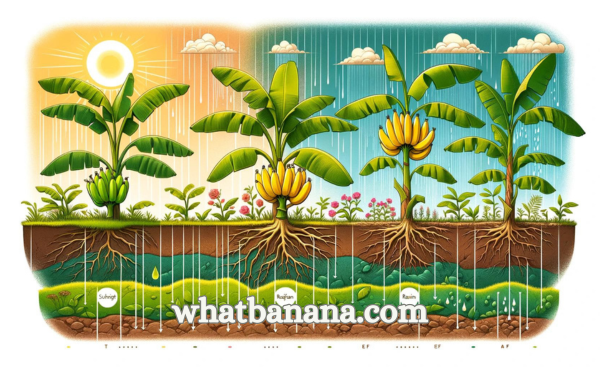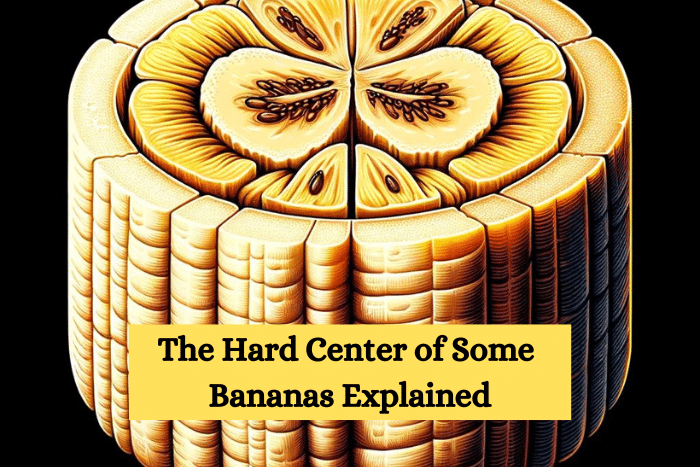A banana’s hard center occurs when temperature dips prevent growth. Cooler temps hinder cell division needed to develop soft banana flesh, so the hard, inedible core inside persists. Removing covers too early after the flower emerges also exposes bananas to temps too low for cells to expand properly.
Have you ever eagerly peeled a beautiful, bright yellow banana only to find an unpleasant surprise inside?
That hard, crunchy, inedible core in the middle of what should be a soft, sweet treat.
It’s a letdown that leads to questions.
Why do some bananas have this tough center while others do not?
Is there something wrong with hard-core bananas or are they still safe to eat if you cut around the center?
Get answers to these questions and more as we peel back the mystery behind the occasional hardcore banana.
🍌 Banana Bonanza Stats 🍌 |
|
|---|---|
| Latent Hard Cores Development | 25% due to marginal temperatures |
| Cavendish Bananas in the US | 99% of all bananas exported |
| Usable Weight Loss from Hard Cores | Up to 40% less |
| Brought to You by whatbanana.com | |
What Is an Extended Period of Dormancy?
We typically think of bananas as tropical fruit.
And this makes perfect sense as they tend to thrive in tropical regions.
Bananas grow best in a region that has an average temperature of 80F (27C).
Plus, a yearly rainfall of 78-98 inches.
Bananas are a perennial plant, and it will typically take 9-12 months from sowing to harvest.
Now, this is all well and good, but you can grow bananas in a non-tropical climate.
However, the plant will usually go through a period of dormancy during the colder winter months.
To prepare the bananas for what’s about to come, it’s advisable to cut back on watering and fertilizing during the growing season.
With that being said, bananas are sensitive to long periods of dormancy, and this will affect their quality when harvested.
So, a hard center could be a sign that your banana was grown in a non-tropical climate and left dormant for too long.
What Happens to Bananas in Cooler Growing Temperatures?
I have touched on this above, but I want to cover this in a little more detail.
As obvious as it sounds, warmer temperatures will produce better-quality bananas.
However, bananas can grow in slightly cooler temperatures and still taste great.
But there is a cut-off point.
If banana plants are kept in an area where temperatures don’t fall below 60F, everything should be fine.
Plus, they will still need to be exposed to light.
As long as they can maintain these conditions, they won’t go dormant, and they will continue to grow and thrive.
Albeit growth will be slightly slower, this won’t impact the quality.
However, if the temperature falls below 50F, the bananas will go dormant.
As I’ve mentioned, this isn’t specifically an issue, but the longer the bananas remain dormant, the more this will affect their quality.
Bananas grown in cold weather will have no apparent signs of physical damage.
Springtime will come, and the bananas will mature, look great, and be ready for harvesting.
Unfortunately, it’s not until you taste them that it becomes obvious that the fruit has been exposed to cold and a longer period of dormancy.
And this will explain why your banana has a hard center.

Is it a Manzano Banana?
The “hard center” appears to be especially prevalent in Manzano bananas.
A Manzano banana is most notable for its appearance and taste.
They are short and chubby, often referred to as the apple banana due to their sweet taste.
This delicious dessert banana has the hint of an apple or strawberry flavor when immature, whereas it is more reminiscent of pineapple flavor when fully ripened.
However, the yellow skin of a Manzano banana turns completely black when it is ripe.
With that being said, they are generally harvested when green and allowed to ripen during shipping.
Manzano is native to tropical countries.
These include the Caribbean, Central, and South America, as well as Mexico.
They also happen to be extremely popular in Asian, African, and Latin American cuisine.
And this is where the problem often lies.
Due to their overwhelming popularity, Manzano’s are often grown in non-tropical climates.
So, in effect, they once again have to go through a stage of dormancy and much colder temperatures.
And this is why Manzano’s often have a hard center.
Manzano Banana Tasting
My Final Thoughts
- Bananas require warm temperatures, around 85 degrees Fahrenheit, to fully develop the soft flesh we expect. Just as plants in your garden don’t thrive in cold weather.
- Cooler weather, while a banana is growing, causes the hard, inedible core to remain inside instead of turning into sweet, soft banana flesh. Similar to how cold weather stunts tomato growth in your vegetable patch.
- Premature removal of banana covers leads to lower temperatures around the growing bananas. Like taking the lid off a pot slowing down the cooking process.
- Varieties like the Dwarf Cavendish don’t cope as well with marginal temperatures. Much like some flower species are less cold tolerant than others.
- Allowing adequate warmth ensures cell division occurs properly so the banana flesh can expand, avoiding the unpleasant core. Similar to how the right room temperature helps bread dough properly rise.
Hopefully, you have a better understanding of why some bananas have a hard center.
This is due to the temperatures at which they’ve grown.
Once the temperature falls below 50F, the bananas will go dormant.
The longer they are left dormant, the greater the impact on quality and flavor.
So, now you know why to check the box and see where your bananas were grown.
And while you are shopping for your favorite fruit snack, here’s some advice on whether you can break off individual bananas from the bunch!
Now that you know what causes those unpleasant hard cores inside some bananas, what will you do differently?
Will you be more selective when choosing bunches of bananas at the grocery store or market?
Paying closer attention to signs they developed properly like more uniform sizing, smooth, bright skins without blemishes, and no trapped humidity inside the plastic wrapping?
Or will you now show some grace by not judging a banana with an odd shape or size, aware it may still be sweet and delicious inside despite going through less than ideal growing conditions?

FAQ
What causes the hard center in bananas?
The hard, inedible core results when the banana pulp or flesh does not properly develop due to cool temperatures during crucial growth periods. This prevents the cells from adequately dividing and expanding.
What temperature do bananas need to grow correctly?
Bananas require warmer tropical temperatures of around 85 degrees Fahrenheit (29 C) to fully form the soft, sweet banana flesh we all enjoy.
Do certain banana varieties get hard centers more often?
Yes. Some varieties like the popular Cavendish don’t cope as well when temperatures are less than ideal during development. Their cells don’t divide properly, leaving a hardy core.
Is a hard-core banana safe to eat?
Hard-core bananas are still safe if you cut around the center. The flesh itself is not harmful or unsafe if the skin still looks fresh and passes the smell test.
How can farmers prevent the hard cores in bananas?
Farmers should take caution to keep developing bananas at optimal warm temperatures, especially at critical growth stages. Protection from cold snaps is also key, as with removing covers prematurely. Careful monitoring helps minimize hard cores.
